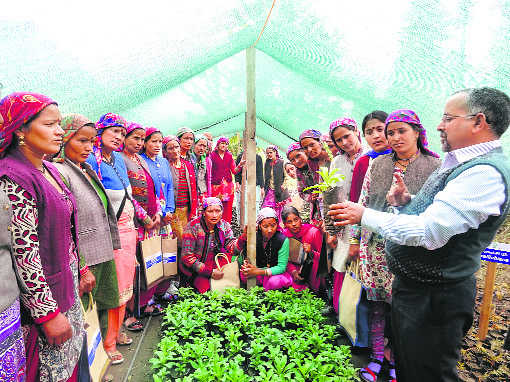
Women farmers learn techniques of growing Picrorrhiza Kurroa at a nursery in Kullu.
Rakesh Lohumi
The ongoing boom in the wellness industry has led to a surge in the global demand for herbal material, raising serious concerns regarding the conservation of the 36 medicinal plant species of Himachal in the “high-volume trade” category, according to the latest assessment.
The study conducted under the aegis of the National Medicinal Plant Board (NMPB) and the Indian Council of Forestry Research and Education during 2015-17 has brought out that the annual trade volume in raw herbs in the country has grown from 317,500 tonne in 2004-05 to 512,000 tonne in 2014-15 with a corresponding increase in the estimated trade value from Rs 1,070 crore to Rs 7,000 crore over the period. The total estimated turnover of the domestic herbal industry for the year 2014-15 stood at Rs 20,000 crore.
Out of the 66 commercially exploited species in Himachal, 36 vulnerable species featured in the “high volume trade” category, out of which 14 are already in the list of endangered medicinal plants. The major species under threat include Mohra, Atis, Bankakri, Salam Panja, Salam Mishri, Kadu, Chirayata, Kutki, Jata Mansi, Brhma Kamal, Taxus Baccata, Bhojpatra and Tejpatta. Besides unregulated, excessive and unscientific exploitation, lots of these species are also depleting on account of habitat loss due to increasing biotic interference and climate change.
“The pressure on herbal resources is increasing due to growing exports, which registered a nine-fold increase, and rising domestic demand with herbal industry clocking a healthy 11 per cent growth over the period. A multi-pronged strategy with appropriate scientific interventions is required for “in-situ” (in the natural habitat) conservation and “ex-situ” (outside the habitat) augmentation and commercial cultivation based on the threat assessment. In addition, long-term measures will have to be taken for preservation of the original germ plasm to maintain purity of genetic material in the long run,” explained Principal Chief Conservator of Forests, GS Goraya, who guided the study along with DK Ved.
The surge in demand presents a great opportunity for states like Himachal, a storehouse of medicinal plants, but also raises concerns about sustainable harvesting practices, quality, authenticity, post-harvest handling, and ethical trade practices related to the herbal material.
Post harvest losses are as high as 20 per cent mainly due to improper handling and lack of standardisation. Much of the cultivated medicinal plant produce gets damaged due to want of necessary infrastructure to dry, clean, chop, grade and package it. There is a need to develop facilities like drying platforms, drying kilns and grading and packaging centres to prevent spoilage and add value to the produce. The government can explore the possibility of utilising the existing apple grading and packaging centres for medicinal plants as an immediate measure.
Referring to efforts being made for conservation, Goraya said sites had been identified for eatablishing Medicinal Plants Conservation Area (MPCA) for Bhoj Patra and Talis Patra at Chitkool, Atis at Kalab in Dodra, Suranjan Kadvi at Udaipur in Lahaul and Ban Lehsukh in Kullu. Species like kala zira, patish, kadu and chirayata have been taken up for commercial cultivation by involving research institutes and non-government organisations.
Chirayata, an important threatened herb, has been successfully cultivated by Shimla-based Himalayan Research Group, which identified Swertia cordata species and standardised agro-techniques for growing it on a commercial scale. A large number of farmers in Chachiot tehsil of Mandi district are cultivating it as a cash crop. However, there is lot more to be done by way of regulatory framework, scientific harvesting, post-harvesting infrastructure and marketing to ensure sustainable exploitation of the dwindling herbal resources.


























